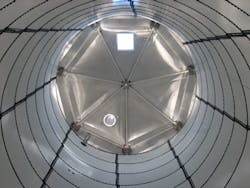In many ways, Watts Bar is a lot like most utility districts – it serves 6,100 customers in parts of five counties in southeastern Tennessee, between Knoxville and Chattanooga. One thing makes it different from most utilities, however, is that its largest customer is a nuclear reactor.
The Watts Bar Nuclear Plant, part of the Tennessee Valley Authority (TVA), sits on 1,700 acres and produces 1,150 MW of electricity – enough to power 650,000 homes. A second reactor, scheduled to open this year, will double that output. The plant uses a lot of water, so much water that the Watts Bar utility maintains an unusually large storage capacity. Containing all that water is a big job, but Aquastore tanks from CST are up to the task. In fact, the utility has 14 Aquastores with a total capacity of more than 5 million gal.
While the nuclear plant draws water directly from the Tennessee River for cooling, it relies on the Watts Bar utility for every drop of water used on a daily basis by its more than 1,000 employees. When a nuclear reactor is relying on you for its water, you cannot afford service interruptions, mechanical issues or contamination. That is why Watts Bar Utility District has relied on Aquastore tanks since the first one was installed in 1988.
Solution
More than 100,000 Aquastore tanks have been installed in more than 70 countries around the world. They are resistant to extreme weather and leakage and retain their luster for decades, which means they do not need to be repainted.
“Not having to paint means we potentially save millions of dollars over just a few years’ time,” said Wesley Barger, assistant manager at Watts Bar Utility District. “Having to ask your board to approve over $4.5 million for tank painting would not go over well.”
Barger credits Southeastern Tank, the area’s exclusive Aquastore distributor, for making his life easier. He says he is continually impressed by the service and attention he receives.
“Every once in a while, something random happens and they’re Johnny on the spot,” Barger said. “For example, when a cable on a tank level snapped, they were out here the next day to replace it.”
Even larger maintenance jobs don’t give Barger gray hairs.
“We took two of the older tanks out of service to fix a bracket supporting an overflow pipe and to add cathodic protection and a sampling port,” he said. “Southeastern did it all, including sweeping out the tanks, in a matter of days.”
Each panel of each Aquastore tank is forged at CST’s DeKalb, Ill., manufacturing facility. A panel of high-strength, low-carbon steel is blasted and alkaline cleaned. The panel’s edges are beveled and its surface sprayed with a stainless steel alloy. Next, the panel is sprayed with a specially formulated slurry that gives it durability, consistency and impermeability; the slurry is inorganic so it blocks corrosion. The panel is then fired at temperatures above 1,500°F to fuse the porcelain coating and the steel. Tests are conducted to verify integrity and durability, including high voltage testing to detect discontinuities.
Results
Barger and his father – general manager Mickey Barger – have witnessed the Aquastore’s efficient construction many times over. It is built using hydraulic jacking, which allows for top-down construction that is safe and fast.
“Most of our customers own two or three tanks, so Watts Bar is truly unique,” said Dustin Dowdy, director of sales at Southeastern Tank in Nashville, Tenn. “With 14 tanks, their lifecycle cost savings can add up quickly, which satisfies their board and customers.”
Whether it is a second nuclear reactor coming online or new home construction, Watts Bar Utility District keeps the taps flowing in southeastern Tennessee, and it starts with storage technology from CST and Aquastore.
